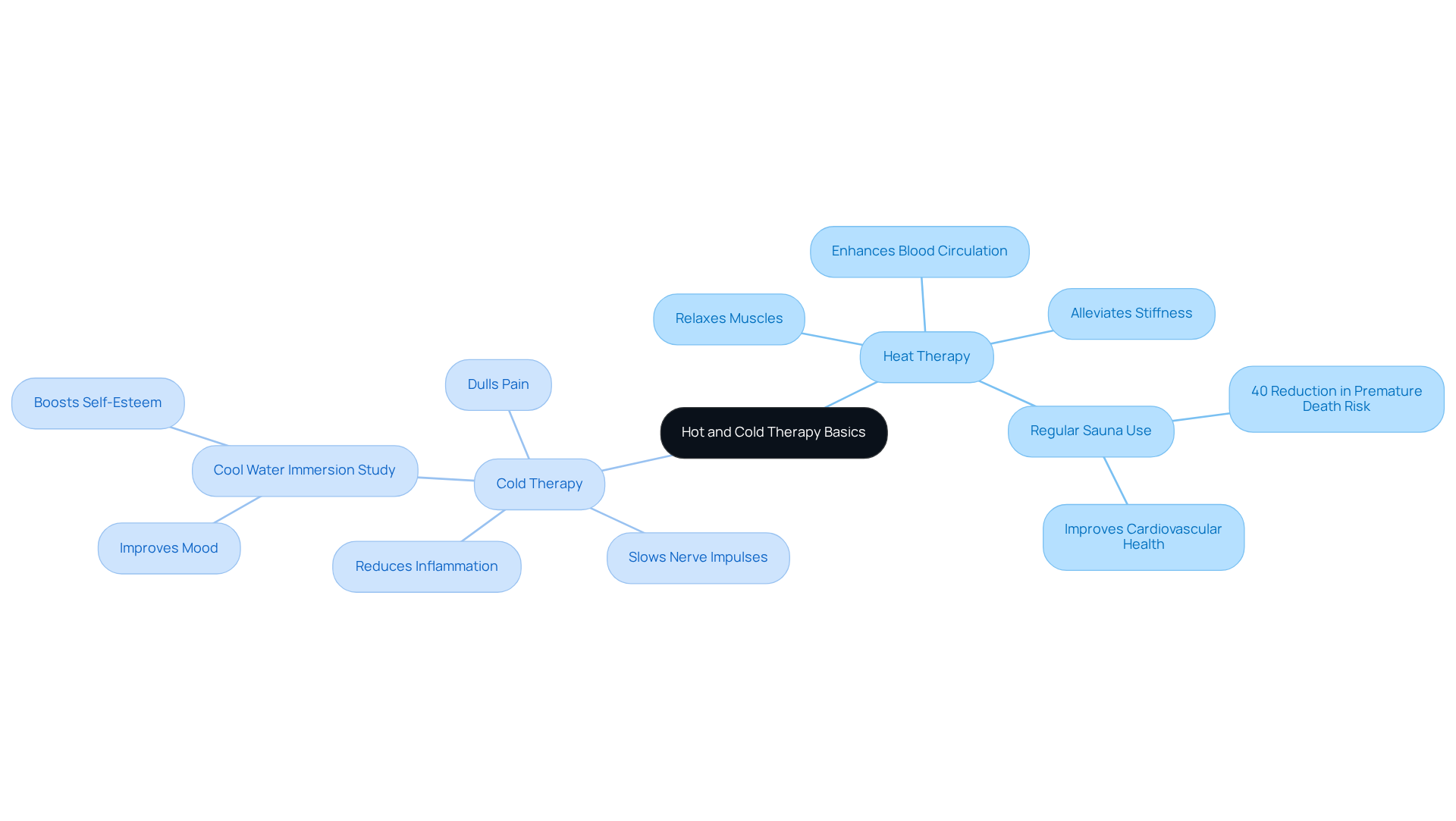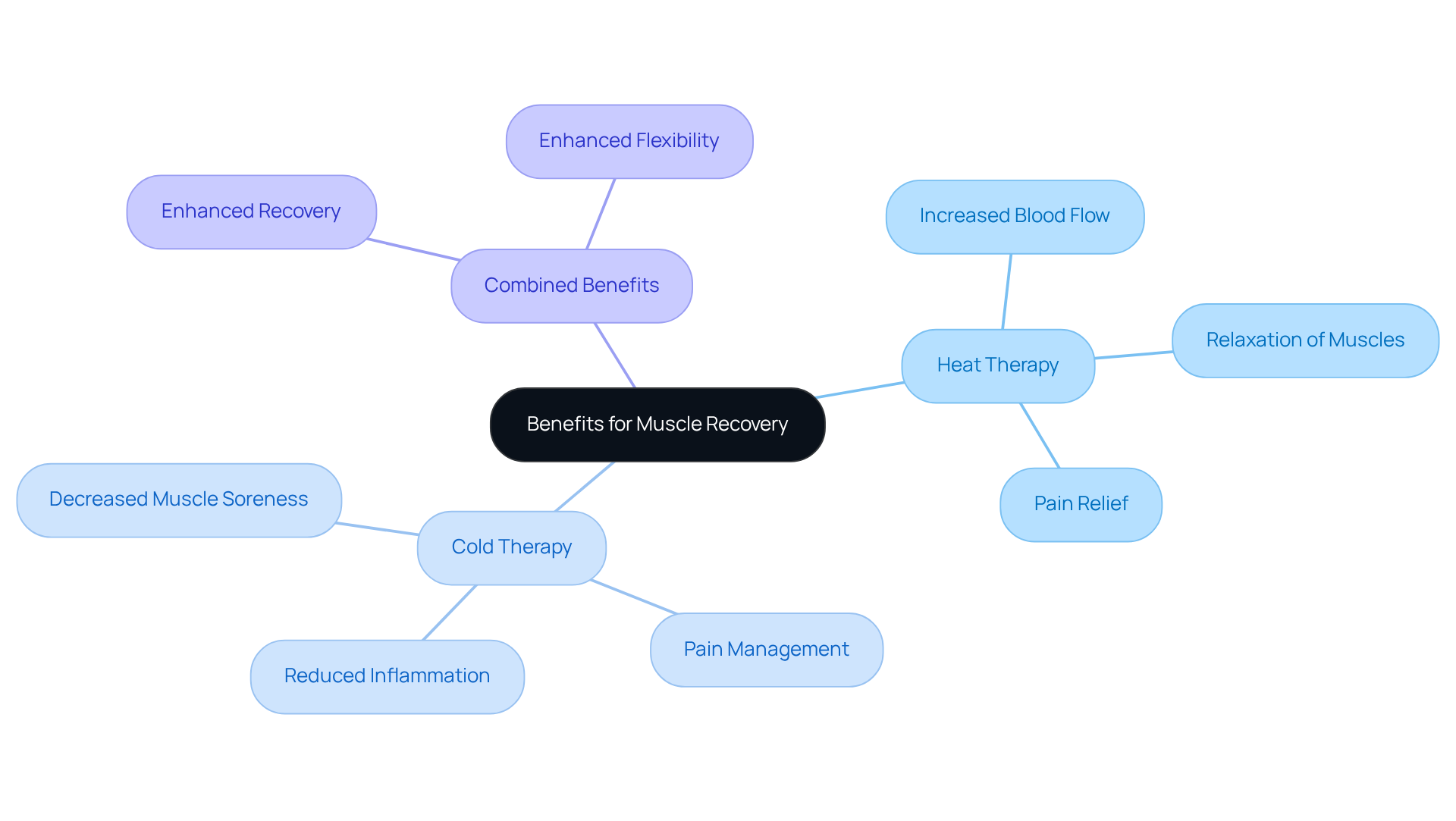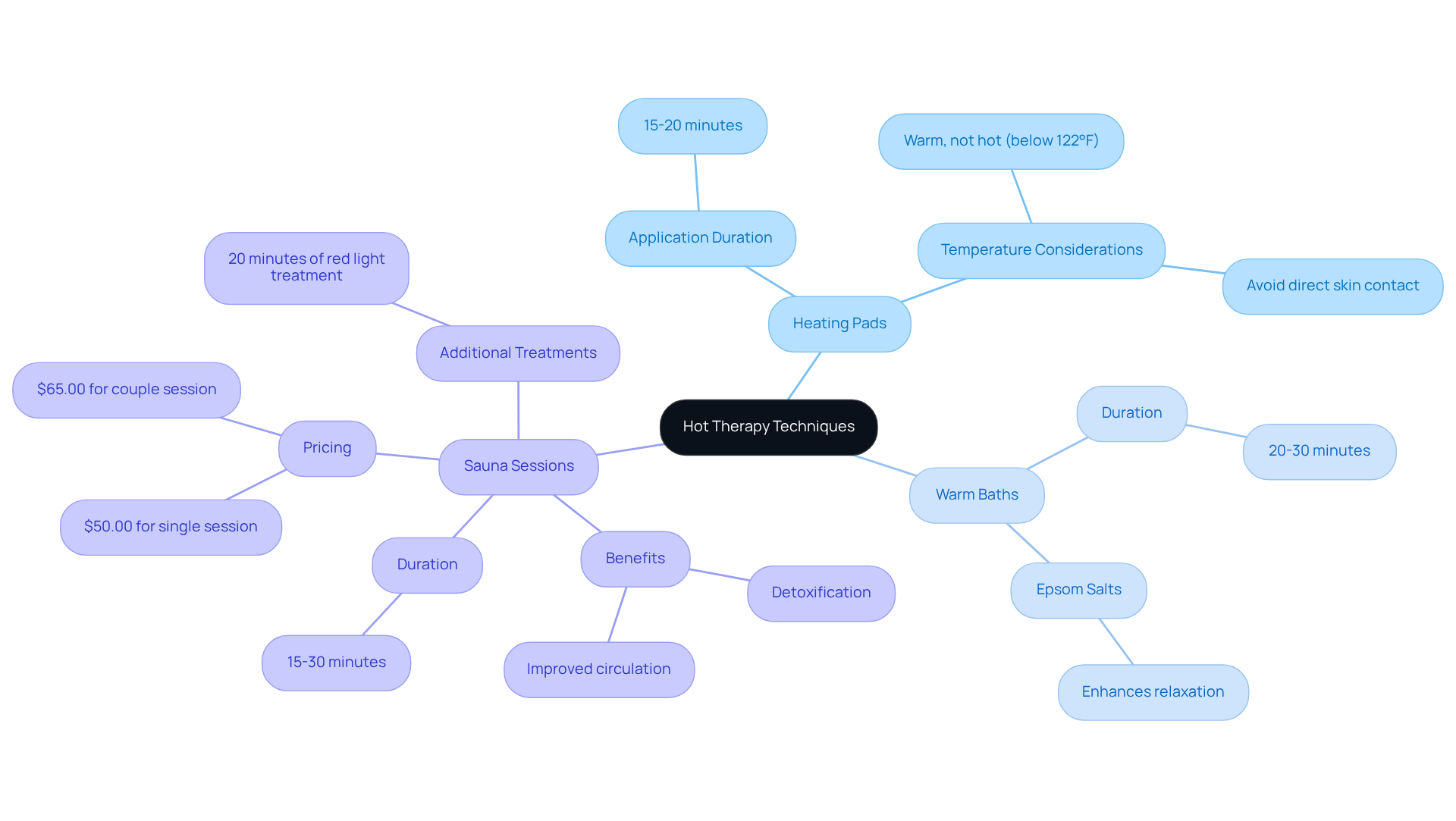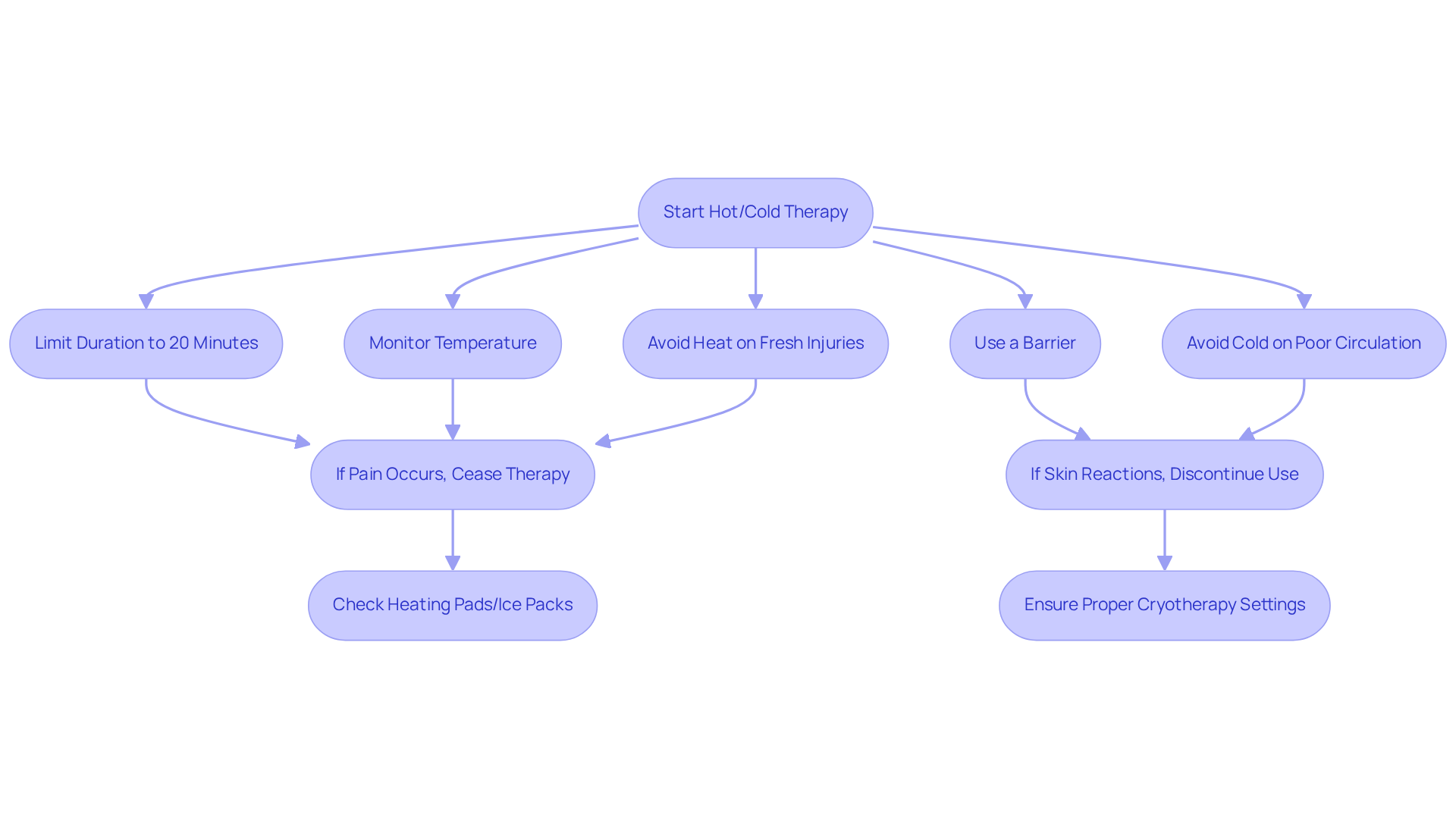Master Hot and Cold Therapy for Effective Muscle Recovery

Overview
Hot and cold therapy is crucial for effective muscle recovery.
- Heat enhances blood circulation and promotes muscle relaxation.
- Cold therapy effectively reduces inflammation and alleviates pain.
These therapies significantly enhance recovery by improving flexibility and minimizing muscle soreness. Research substantiates their physiological benefits when applied correctly, making them indispensable tools for anyone serious about optimizing their recovery process.
Introduction
Hot and cold therapy has emerged as a transformative approach in muscle recovery, leveraging the natural healing properties of temperature to optimize physical performance. By understanding the distinct benefits of heat and cold treatments, individuals can unlock a powerful toolkit for alleviating pain, reducing inflammation, and enhancing overall well-being.
However, the question remains: how can one effectively balance these therapies to maximize recovery and avoid potential pitfalls? This guide delves into the intricacies of hot and cold therapy, offering insights and techniques that promise to elevate muscle recovery to new heights.
Understand Hot and Cold Therapy Basics
Thermotherapy and cryotherapy, often referred to as , serve as powerful modalities for healing and recovery. By applying hot and cold treatments to the body, these methods facilitate significant physiological benefits.
- Heat therapy enhances blood circulation, relaxes muscles, and alleviates stiffness, making it an effective solution for chronic pain and muscle tension.
- Notably, regular sauna use has been linked to a remarkable 40% reduction in the risk of premature death, underscoring its long-term health advantages.
Conversely, cold treatments serve to reduce inflammation, dull pain, and slow nerve impulses, proving especially beneficial for acute injuries.
- A compelling study indicates that cool water immersion at temperatures between 10 to 15 degrees Celsius can significantly diminish negative emotions while boosting self-esteem, highlighting the psychological benefits of cold therapy.
As you consider these treatments, recognize their potential to enhance both physical and mental well-being, making them invaluable tools in your health regimen.

Identify Benefits for Muscle Recovery
Hot and cold treatment offers significant benefits for physical recuperation, making it a favored method among athletes and fitness enthusiasts. At Tsavo Wellness, we emphasize pathways to balance and rejuvenation through our advanced healing techniques, including lymphatic massage and red light therapy. Here are the key benefits:
Benefits of Heat Therapy:
- Increased Blood Flow: Heat therapy enhances circulation, delivering more oxygen and nutrients to muscles, which is essential for effective recovery. Research indicates that local heat treatment can stimulate mTOR signaling, thereby enhancing protein synthesis and facilitating recovery after intense exercise.
- Relaxation of Muscles: This treatment alleviates tension and stiffness in muscles, promoting easier stretching and movement. , maintained between 94 and 104 degrees, have been shown to improve blood flow and stimulate endorphin release, contributing to relaxation.
- Pain Relief: Heat treatment mitigates chronic pain conditions, such as arthritis or tissue spasms, by increasing tissue metabolism and reducing discomfort. However, caution is advised, as prolonged exposure can lead to burns.
Benefits of Cold Therapy:
- Reduced Inflammation: Cold therapy effectively minimizes swelling and inflammation, particularly following acute injuries or intense workouts. Cold water immersion (CWI) has been demonstrated to reduce swelling and delayed-onset muscle soreness (DOMS) after strenuous exercise, making it a favored choice for athletes.
- Pain Management: It numbs the affected area, providing immediate pain relief. Studies suggest that cold treatment can lead to quicker recovery of strength after resistance training.
- Decreased Muscle Soreness: Cold treatment is effective in reducing DOMS, enabling athletes to recover more swiftly after demanding activities.
Combined Benefits:
- Enhanced Recovery: Alternating between hot and cold therapies can significantly improve overall recovery times by promoting better circulation and reducing muscle fatigue. Research involving 100 college-aged participants indicates that heat application is more effective for strength restoration immediately post-exercise, while cold treatment excels 24 hours after physical activity.
- Enhanced Flexibility: Regular application of these treatments can lead to improved flexibility and range of motion, which are crucial for optimal performance.
By understanding these benefits, you can effectively integrate hot and cold therapy into your rehabilitation routine at Tsavo Wellness, which optimizes your performance and wellbeing while supporting restoration at the cellular level.

Apply Hot and Cold Therapy Techniques
Hot Therapy Techniques:
- Heating Pads: For effective relief, apply a heating pad to the affected area for 15-20 minutes. It’s crucial to ensure the pad is warm rather than hot, as temperatures exceeding 122°F can lead to skin damage.
- Warm Baths: Consider soaking in a warm bath for 20-30 minutes. The addition of Epsom salts can significantly and aid in physical recuperation.
- Sauna Sessions: Experience the benefits of Tsavo Wellness's state-of-the-art infrared sauna in Mosman, Sydney. Constructed from clear light cedarwood and equipped with in-room shower facilities, this sauna offers a 15-30 minute session that promotes complete relaxation, detoxification, and improved circulation. The infrared light elevates your body's internal temperature, creating a hot and cold effect that supports detoxification, enhances metabolism, and bolsters the immune system. For those seeking additional therapeutic benefits, an extra 20 minutes of red light treatment is available. Sessions are affordably priced at $50.00 for a single and $65.00 for a couple, making it an accessible choice for individuals pursuing balance and renewal.

Follow Safety Guidelines and Troubleshooting Tips
While the benefits of hot and cold therapy for muscle recovery are substantial, it is imperative to adhere to to prevent injuries. Start by limiting the duration of application; heat or cold should be applied for no longer than 20 minutes at a time to avoid burns or frostbite. Protect your skin by using a barrier, such as a towel, between the treatment source and your skin to prevent direct contact. Additionally, monitor the temperature to ensure it remains comfortable, avoiding any sensation of pain or extreme discomfort. It is crucial to avoid using heat on fresh injuries or swollen areas, particularly if you have conditions like diabetes or circulatory issues. Cold treatment should also be avoided on areas with poor circulation or open wounds.
In case of any issues during therapy, it is essential to follow certain troubleshooting tips:
- If you experience pain, cease therapy immediately and consult a healthcare professional if the pain persists.
- Should you notice any skin reactions, such as redness or irritation, discontinue use and seek medical advice.
- Furthermore, verify that your heating pads or ice packs are functioning correctly.
- For cryotherapy machines, ensure that proper settings and maintenance are in place.
By diligently following these safety guidelines and troubleshooting tips, you can safely and effectively incorporate hot and cold therapy into your muscle recovery regimen.

Conclusion
Mastering hot and cold therapy can significantly enhance muscle recovery, providing a holistic approach to physical wellness. By understanding the distinct benefits of heat and cold treatments, individuals can effectively alleviate pain, reduce inflammation, and promote overall healing. Incorporating these modalities into a regular routine supports physical recovery and contributes positively to mental well-being.
This article outlines the fundamental principles of thermotherapy and cryotherapy, emphasizing their unique advantages. Heat therapy improves blood circulation and relaxes muscles, while cold therapy effectively reduces inflammation and numbs pain. Together, these treatments can enhance recovery times, flexibility, and overall athletic performance. Adhering to safety guidelines is crucial to maximize benefits and minimize risks, ensuring a safe and effective recovery process.
Ultimately, embracing hot and cold therapy as part of a comprehensive recovery strategy can lead to improved health outcomes. Whether through simple techniques like heating pads and cold packs or more advanced options such as sauna sessions and cryotherapy, individuals are encouraged to explore these powerful tools. By prioritizing muscle recovery through these methods, one can achieve not only physical restoration but also a deeper sense of well-being and vitality.
Frequently Asked Questions
What are thermotherapy and cryotherapy?
Thermotherapy refers to heat treatments, while cryotherapy refers to cold treatments. Both serve as powerful modalities for healing and recovery.
What are the benefits of heat therapy?
Heat therapy enhances blood circulation, relaxes muscles, alleviates stiffness, and is effective for chronic pain and muscle tension.
How does regular sauna use impact health?
Regular sauna use has been linked to a 40% reduction in the risk of premature death, highlighting its long-term health advantages.
What are the benefits of cold therapy?
Cold therapy reduces inflammation, dulls pain, and slows nerve impulses, making it especially beneficial for acute injuries.
What psychological benefits are associated with cold water immersion?
A study indicates that cool water immersion at temperatures between 10 to 15 degrees Celsius can significantly diminish negative emotions and boost self-esteem.
How can hot and cold therapies enhance well-being?
Both hot and cold therapies have the potential to enhance physical and mental well-being, making them valuable tools in a health regimen.


